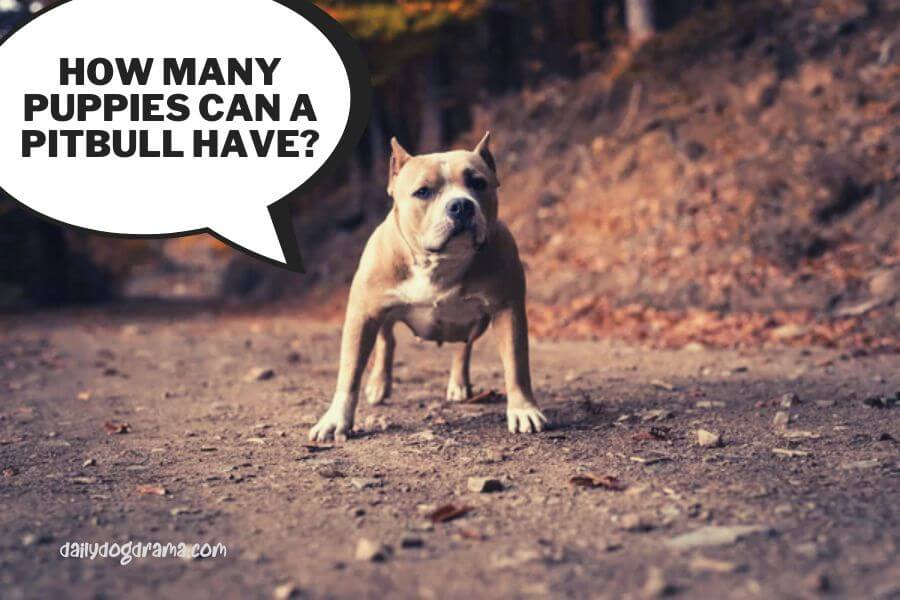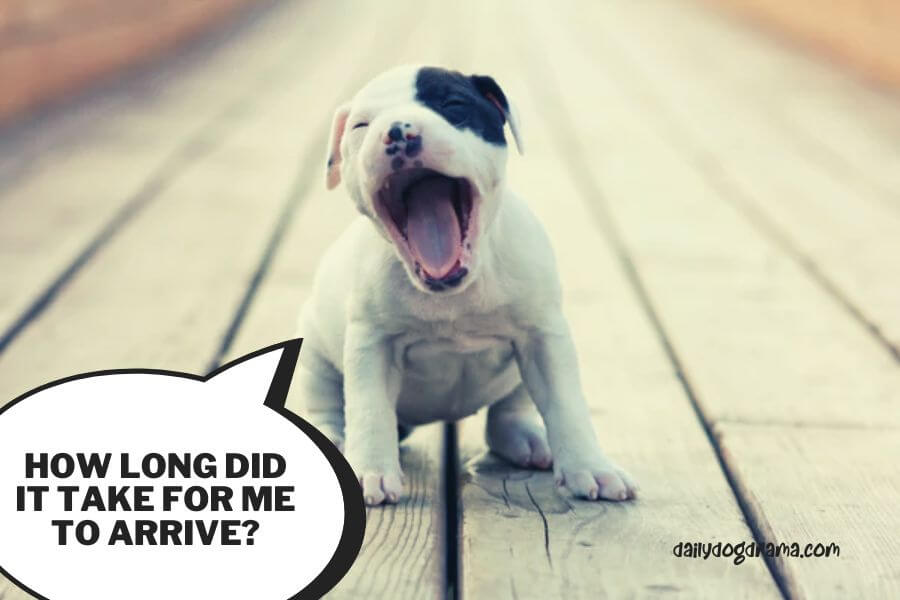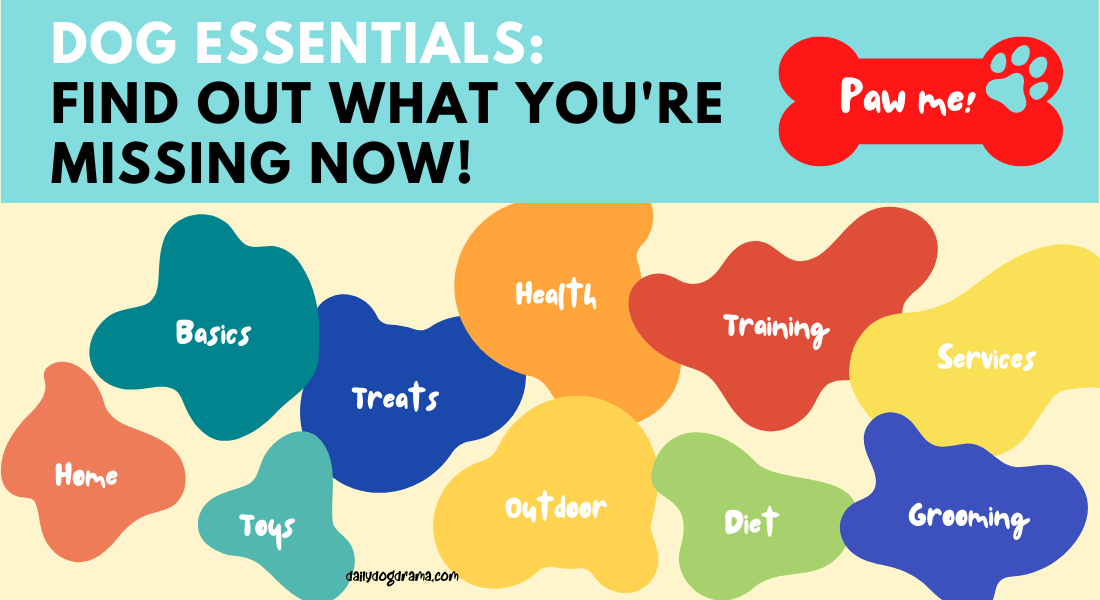Do you know what DOG ESSENTIALS you are missing out? Find out now!
Zack Keithy, our author, is a certified veterinarian technician (UC Blue Ash) for over 6 years (contact him here). The articles written here are based on his expertise and experience, combined with a review by our expert vet reviewers including Dr M. Tarantino. Learn more about us here.
Pitbulls are one of the most popular breeds of dogs in the United States even though they sometimes receive bad press.
There are many reasons for this, but one of the main reasons is that they actually make great family pets.
If you’re thinking about breeding pit bulls or if your girl is pregnant now, there are a few things you need to know to ensure a healthy litter of puppies, for example, how many puppies can a pitbull have?
Pitbulls have 5 to 6 puppies on average in a litter, but this number can range between 1 and 14 depending on a number of factors. Once pit bulls reach sexual maturity, they are ready to have babies.
In this blog post, we’ll cover everything including litter size, their heat cycles, and caring for a pregnant pit bull.
Medical Questions? Talk to a Veterinarian 24/7.
Connect one-on-one with a licensed vet who will answer your questions in minutes.
*Article may contain affiliate links to retailers like Amazon and Chewy. Learn more on our disclosure page.

- Some Facts and Trivia About Pit Bulls
- How Many Puppies Can a Pitbull Have in One Litter?
- How Many Healthy Litters Can a Pitbull Have in Their Lifetime?
- What Determines the Number of Pitbull Puppies in a Litter?
- At What Age Can You Breed a Pitbull?
- What Age Do Pitbulls Go in Heat?
- How Do You Know if Your Pitbull is in Heat?
- How Often Do Pitbulls Go Into Heat?
- How Long Does a Pitbull Stay in Heat?
- How to Tell if My Pitbull is Pregnant?
- How Long is a Pitbull Pregnant for?
- How Do I Know When My Pitbull is About to Give Birth?
- Pitbull Puppy Size/Growth Chart
- Care Tips for a Pregnant Pitbull
- Should You Breed Pitbulls?
- Frequently Asked Questions (FAQs)
- How many puppies can a blue nose Pitbull have?
- How many puppies can a red nose Pitbull have?
- How much do pitbulls cost?
- Do pitbulls need C-sections to give birth?
- How many litters can a pitbull have in a year?
- Can a pit bull have 12 puppies?
- Can a pit bull have 14 puppies?
- How many puppies can a pitbull have in her first litter?
- How many puppies do pitbulls have in their second litter?
- What is the biggest litter a pitbull can have?
- In Conclusion: How Many Puppies Can a Pitbull Have?
Some Facts and Trivia About Pit Bulls
I thought it would be interesting to share some facts and trivia about pit bulls so that we can all know this unique dog better!
- Pit bulls are not a pure breed dog, but rather a name for many breeds of dog including the American Pit Bull Terrier, American Staffordshire Terrier, American Bully, Staffordshire Bull Terrier, and occasionally the American Bulldog.
- Pit bulls are not necessarily born aggressive but rather they’re bred to be aggressive toward other dogs. This is why it’s important when adopting a pit bull to socialize them early on so that they can coexist with humans and other animals.
- Pit bulls have been bred for centuries to be fighting dogs—they were originally bred from English bulldogs and terriers to create a canine that was both strong and agile to compete in dog fighting rings.
- Pitbulls are known for being incredibly loyal and protective of their owners, which is why they make such great family pets. But did you know that pitbulls can also be good with children?
How Many Puppies Can a Pitbull Have in One Litter?
Some pitbulls have litters as small as one, but others can have up to 14 puppies in one litter.
The average size for a pit bull litter is between 5 and 7 puppies.
There is no way of accurately predicting the exact number, but as a medium to large breed dog, they typically will have more puppies compared to small and toy breeds.
Other factors also influence the number of puppies in a litter, which I will share more on in the sections below.
How Many Healthy Litters Can a Pitbull Have in Their Lifetime?
In theory, a pitbull does not experience menopause, so they stay sexually active until they die.
And since a pitbull starts going into heat from 6 months to 12 months old, and typically has two heat cycles each year, you can do the math.
However, things are not as simple as adding some numbers up.
An ethical and reputable breeder will limit the number of times a pitbull mates to once a year and does not breed a single dam more than 4 to 6 times in their lifetime.
This is so that the dog can be spayed while it is still young, and of course, excessive breeding will take a serious toll on the dog’s health too.
There are also countries that legally limit the number of times a dog can be bred, and that number is usually 4 to 6 times.
In the US, the American Kennel Club (AKC) does not accept registrations for dams that are bred over the age of 12 and under 8 months, and sires that are over the age of 12 and under 7 months.
What Determines the Number of Pitbull Puppies in a Litter?
In this section, we’ll discuss the key factors that determine the number of pitbull puppies in a litter.
1. Age of the dam
As a general rule, as a dam gets older, the size of the litter becomes smaller.
Interestingly, the couple of litters are usually smaller than the subsequent litters, so you should expect more pups from the third time you are breeding your pittie.
Even if your female is fertile for the rest of her life, you should not breed a dog over the age of 8 – that’s too old to have puppies!
Ideally, you should finish breeding long before that and spay your dog, which can have positive health implications for them.
2. Age of the sire
The age of your Pitbull puppies’ father will also have an impact on the litter size although not as much as the mother’s.
When a dog reaches the age of 5 to 6 years, his sperm quality begins to deteriorate.
Even if the female is very fertile, this can result in fewer puppies per litter.
In some cases, breeders will turn to using artificial insemination to aid in the breeding of older males.
3. Health of the mom
When you are considering breeding your pittie, the health of the must come first.
A sickly mother will have a weak baby.
Keeping track of the mother’s weight is an important step during pregnancy.
For example, if the mother is overweight, she will likely develop joint problems and, like a human mother, may cause complications during delivery.
To avoid these difficulties, try not to overfeed your dog, as this will lead to obesity, which will cause unnecessary problems.
Also of note is that there must be enough time between litters to ensure the female pit bull has sufficient time to recover.
4. Size of dog
A mother’s size is very important in determining the number of puppies in a litter too.
Different dogs within the same breed can range in size and I do not mean greater in terms of weight but rather, I mean larger in terms of build.
The basic guideline is that Pitbulls with greater frame sizes produce larger litters.
A large-sized female Pitbull has been seen to be capable of giving birth to 8–12 pups at once, or even 14 on some rare occasions.
A smaller or medium-sized Pitbull, on the other hand, will likely have 5–6 puppies.
5. Litter in which mom was born
The level of fertility in your Pitbull often comes from her mother.
If she was born into a large litter herself, she will most likely have a large first litter.
Conversely, you can probably anticipate that your pittie will have a small first litter if she herself was born in a small litter.
6. Type of breeding
This is really a topic meant for another article as it can get complicated very quickly.
But in a nutshell, how a dog was bred can have a big impact of its litter size too.
For example, with inbreeding, a litter’s quality can be destroyed especially when it occurs at high levels.
In this scenario, it will decrease the size of the litter and have an impact on the puppies’ health by reducing their lifespan and increasing their susceptibility to inherited diseases.
The likelihood of developing these problems increases as the dogs get closer together.
Conversely, linebreeding is often a safer way to breed dogs as it aims to maintain enough genetic diversity while preserving the best genes from a bloodline.
7. Time of breeding
It is said that a dam is more likely to have a larger litter size the closer she is to ovulation.
This is defined as the period after the estrogen period when the Luteinizing hormone triggers ovulation.
Unfortunately, I have not been able to find any studies supporting this theory, so at this point, I would say this factor is not significant.
At What Age Can You Breed a Pitbull?
It is recommended to wait until at least the second heat cycle before breeding a pitbull.
This is due to the fact that they may not be mature enough to breed when their first heat cycle comes around, sometimes as early as 6 months old.
Responsible breeders typically wait until the dog is older than 2 years old before breeding them because by then, they should have passed all of their health examinations.
What Age Do Pitbulls Go in Heat?
A female pit bull can experience her first heat cycle at any age between 6 and 24 months.
However, this seems to happen more frequently when the dog is between 6 and 12 months old.
While some puppies as young as four months old may experience their first heat, larger breeds like pitbulls typically experience it at six months or later.
How Do You Know if Your Pitbull is in Heat?

Bloody discharge, receptivity to male dogs, agitated behavior, and many other symptoms can be signs of a dog in heat.
Here’s a breakdown:
- Swollen vulva
- Discharge from the vulva
- Receptive to male dogs
- Change in appetite
- Excessive licking of the genital area
- Agitated, anxious, or aggressive behavior
- Urinating more frequently
- Holding its tail close to the body
How Often Do Pitbulls Go Into Heat?
Most pitbulls have a heat cycle after their first season every 6-7 months (twice a year).
While some dogs’ cycles may be a little bit longer or shorter, they should occur on a regular basis, and you should be recording this.
If your dog has inconsistent seasons, consult your veterinarian to find out if there is anything that is affecting this.
As dogs age, there are typically longer seasons between them (but can still get pregnant).
How Long Does a Pitbull Stay in Heat?
When a dog is said to be in heat, we are referring to the estrus phase of the heat cycle.
The entire cycle is as follows, and it is during the estrus period when a dog will show all the signs discussed above:
- Phase 1: Proestrus (~7 to 10 days)
- Phase 2: Estrus (~5 to 14 days)
- Phase 3: Diestrus (~10 to 140 days)
- Phase 4: Anestrus (~6 months)
How to Tell if My Pitbull is Pregnant?
Here are the most common signs that your pittie is pregnant:
- Nipples enlarged
- Increased hunger
- Irritability (may have a short temper)
- Decrease in activity and energy levels
- Behavioral changes
- Weight gain
- Starts nesting
- Seeks more attention
When you notice all of these happening, and it is about 25 days after mating, you should bring your pittie to the vet for an ultrasound or a blood test.
How Long is a Pitbull Pregnant for?

Dogs, no matter the breed, are usually pregnant for 56-64 days, or about 2 months.
There won’t be many, if any, obvious indicators of pregnancy in the first two weeks in your dog as the changes are currently taking place internally within the uterus.
However, your pitbull will soon start to lose hair around the breasts, develop larger, darker nipples, and develop darker nipples at around 3 weeks of pregnancy.
How Do I Know When My Pitbull is About to Give Birth?
It is good to be aware that dogs usually give birth around 2 months after getting pregnant so that you can prepare for it.
As the time draws nearer, there will be a number of telltale signs that your dog might be whelping soon.
- Restlessness
- Vomiting
- Not eating much
- Digging and scratching
- Lethargy
- Start producing milk
- Spending more time in her “nest”
- Shivering
- Panting
- Straining
- Drop in body temperature
Pitbull Puppy Size/Growth Chart
The table below shows you the estimated weight at each life stage during a pit bull’s growing years.
When they go into adulthood (> 1 year old), they might put on a few more pounds but their weight gain will be much slower and you will see a consistent weight throughout this period.
| Age in months | Male Pitbull (kg) | Male Pitbull (lb) | Female Pitbull (kg) | Female Pitbull (lb) |
|---|---|---|---|---|
| 1 | 1.36 – 2.27 | 3 – 5 | 0.91 – 1.81 | 2 – 4 |
| 2 | 2.27 – 6.80 | 5 – 15 | 2.27 – 6.80 | 5 – 15 |
| 3 | 4.34 – 8.68 | 10 – 20 | 4.34 – 8.68 | 10 – 20 |
| 4 | 6.80 – 11.34 | 15 – 25 | 4.34 – 8.68 | 10 – 20 |
| 5 | 6.80 – 13.61 | 15 – 30 | 6.80 – 11.34 | 15 – 25 |
| 6 | 8.68 – 15.88 | 20 – 35 | 6.80 – 13.61 | 15 – 30 |
| 7 | 8.68 – 18.14 | 20 – 40 | 6.80 – 15.88 | 15 – 35 |
| 8 | 11.34 – 20.41 | 25 – 45 | 8.68 – 15.88 | 20 – 35 |
| 9 | 11.34 – 22.68 | 25 – 50 | 8.68 – 18.14 | 20 – 40 |
| 10 | 11.34 – 22.68 | 25 – 50 | 11.34 – 18.14 | 25 – 40 |
| 11 | 13.61 – 24.95 | 30 – 55 | 11.34 – 20.41 | 25 – 45 |
| 12 | 13.61 – 27.21 | 30 – 60 | 13.61 – 22.68 | 30 – 50 |
Care Tips for a Pregnant Pitbull
Pregnant pit bulls are absolutely beautiful, but they also come with some very specific needs. Here are some care tips for when you have a pregnant pitbull:
Regular checkups
You need to schedule regular checkups with your vet, especially in the last few weeks of pregnancy, and when you notice any changes in your dog’s behavior.
This will help make sure that everything is going as it should be during pregnancy and birth.
Balanced diet
During pregnancy, your pitbull really needs to eat a balanced diet.
This means that she should get plenty of protein (chicken is a good choice), and some fruits and vegetables for vitamins and minerals.
You can also supplement the diet with calcium tablets or other supplements if you want to be extra careful about making sure your dog gets everything she needs during this time.
Quiet environment
It’s important to keep your dog in a quiet environment during pregnancy, especially if she is pregnant with her first litter.
This will help make sure that she doesn’t get stressed out, which can lead to complications during birth and for the puppies themselves.
If you know that there are going to be loud noises, such as fireworks or other people in the house, then make sure to keep your pitbull inside and away for those times so she doesn’t get frightened by all of the commotions.
Activity
Pregnant dogs shouldn’t engage in strenuous exercise, but they can certainly benefit from attention, moderate playtime, and frequent brief walks.
A pregnant dog shouldn’t be overstimulated, but you also shouldn’t let her get lazy.
It’s crucial that the pregnant dog be kept apart from other dogs and animals during the final three weeks of pregnancy, so during this time, let her have some light exercise indoors rather than taking her outside.
Should You Breed Pitbulls?
If you believe you are an experienced breeder who will complete the breeding process smoothly, you may take a chance; otherwise, breeding your Pitbull by yourself is a no-no.
Breeding requires a highly experienced and professional individual, and negligence will result in unhealthy, unborn, or fewer puppies, i.e., 2-3 puppies per litter.
If you want to sell puppies as a business, breeding is a good option. Otherwise, you can expand your Pitbull family by adopting pit bulls from shelters. They will have a new owner, and you will have more joy for your family. Because caring for Pitbulls is a difficult routine in and of itself.
Frequently Asked Questions (FAQs)
How many puppies can a blue nose Pitbull have?
On average, a blue nose Pitbull will typically have 5 puppies per litter. If the female is in good health, well-fed, the breeding takes place close to ovulation, and you’re lucky, you might even get up to 10 puppies.
How many puppies can a red nose Pitbull have?
On average, a red nose Pitbull will typically have 5 puppies per litter. If the female is in good health, well-fed, the breeding takes place close to ovulation, and you’re lucky, you might even get up to 10 puppies.
How much do pitbulls cost?
The cost of buying a pitbull can vary widely, as it depends highly on the breeds and their lineage. In general, you can expect the price range to be between $500 to $5,000. Lots of pitbulls are found in shelters, so that might be a better place to start finding them.
Do pitbulls need C-sections to give birth?
Dogs don’t typically undergo cesarean sections; they typically only do so when there are delivery-related difficulties, such as an abnormally small pelvis, or probable problems that could occur with a natural birth.
How many litters can a pitbull have in a year?
A pittie can have up to 2 litters a year, but it is considered ethical to only breed them once a year.
Can a pit bull have 12 puppies?
Yes, a pit bull can possibly have 12 puppies, and this depends on a number of factors such as the size of the dog, genetics, age, and health condition.
Can a pit bull have 14 puppies?
Yes, a pit bull has the potential to have 14 puppies, and this depends on a number of factors such as the size of the dog, genetics, age, and health condition.
How many puppies can a pitbull have in her first litter?
The first litter of a pitbull is usually smaller than the next two litters but in general, it should have about 5 to 6 puppies in her first litter.
How many puppies do pitbulls have in their second litter?
After her first litter, a pitbull might see an increase in litter size in subsequent deliveries. That said, it still comes down to its physical size and condition, but 6 to 8 puppies are not uncommon.
What is the biggest litter a pitbull can have?
There has been some news coverage on the largest litter size of a pitbull, and that number is 20! It belongs to Dixie the American Pit Bull, who had 10 boys and 10 girls in May 2009.
In Conclusion: How Many Puppies Can a Pitbull Have?
So, there you have it: everything you need to know about how many puppies a pitbull can have!
As you can see, there are a lot of factors that go into determining how many puppies a pitbull will have.
But one thing is for sure: the more you know about your dog’s breed and their reproductive cycle, the better equipped you’ll be to make decisions about when and how to breed them.
Check out other articles about dog breeds such as the Chow Chow x Pomeranian mix, can you breed half sibling dogs, Japanese Spitz vs American Eskimo, or learn about the litter sizes of other breeds here.
You’ve made it to the end, but I hope it’s not the end of our journey. We want to hear your voice! Share your thoughts, problems, suggestions, or anything related to your dog in the comments section. And don’t forget to join our newsletter today too.




